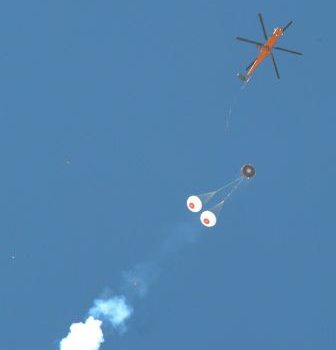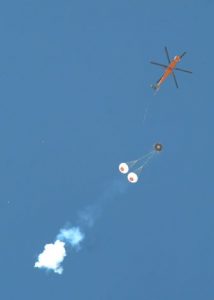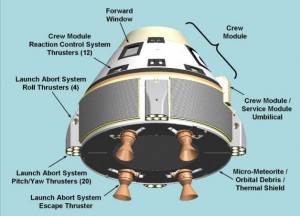

The CST-100 being dropped from an Erickson Air Crane helicopter above Delamar dry lake bed (Credits: The Boeing Company).
On May 2, The Boeing Company completed parachute drop testing of its Crew Space Transportation or CST-100 capsule. The reusable capsule is being developed under NASA’s Commercial Crew Development program. So far all testing has been successful and remains on schedule for a 2015-16 test launch.
“This second parachute drop test validates Boeing’s innovative system architecture and deployment plan,” said John Mulholland, vice president and program manager of Boeing Commercial Programs. “Boeing’s completion of this milestone reaffirms our commitment to provide safe, reliable and affordable crewed access to space.”
The test involved dropping the capsule from an altitude of 4,267 m via helicopter above a dry lake bed in Nevada. The capsule descended with nominal parachute deployment and landed smoothly, cushioned by six inflated air bags. The parachute system was designed by HDT Airbone Systems and the air bags by ILC Dover. The test capsule itself was provided by Bigelow Aerospace which plans to use the spacecraft to ferry people to a planned space complex.
“We’re thrilled to see the robust progress that is being made via the Commercial Crew program,” said Bigelow founder and President Robert T. Bigelow in a news release. “This successful test provides further proof that the commercial crew initiative represents the most expeditious, safe and affordable means of getting America flying in space again.”
Boeing is in the process of setting up CST-100 operations in the former Shuttle Orbiter Processing Facility at the Kennedy Space Center in Florida per an agreement with NASA. The company plans to complete additional testing of the CST-100 in 2012 including an airbag test series, a forward heat shield jettison test, and an orbital maneuvering/attitude control engine hot fire test. The capsule is designed to transport up to 7 astronauts and will launch aboard an United Launch Alliance Atlas V rocket in 2015-16 if all goes according to plan, although it is designed to be compatible with multiple launch vehicles. This date may be pushed back to 2017 due to low NASA funding levels.
Below is a video of Boeing’s first parachute drop test of the CST-100 in April:


















































































































![A trajectory analysis that used a computational fluid dynamics approach to determine the likely position and velocity histories of the foam (Credits: NASA Ref [1] p61).](http://www.spacesafetymagazine.com/wp-content/uploads/2014/05/fluid-dynamics-trajectory-analysis-50x50.jpg)



Leave a Reply